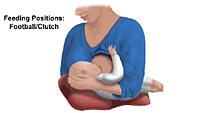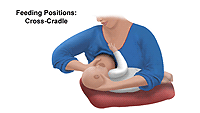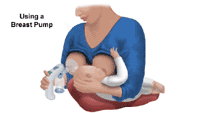Breastfeeding Your High-Risk Baby
Breastfeeding carries many benefits for almost all mothers and babies, but even more so for high-risk babies. You can be an important part of the healthcare team by providing your baby with breast milk in the NICU. Your baby may not be ready to nurse at the breast yet. Until he or she is ready, you can express milk for your baby. If your baby is getting ready to feed at the breast, the following information can help you with this transition. Give your high-risk baby extra time to learn to breastfeed, and let the baby set the pace for learning. Learning to breastfeed effectively is a process that may take days or weeks for premature and many other high-risk babies. But you and your baby can become a breastfeeding team if you are patient and persistent, and maintain a healthy perspective.
Signs a baby is getting ready to nurse
Let your healthcare provider and your baby's nurses know that you would like to breastfeed as soon as your baby is ready to start feeding by mouth. In general, a baby must be able to suck-swallow-breathe in a coordinated way to take food by mouth. Some of the signs that a baby is getting ready to do this include:
-
Physical stability. A baby's condition should be stable so the baby can physically handle being held and fed.
-
Non-nutritive sucking. A baby first displays rhythmic sucking on a pacifier or feeding tube in brief bursts of more than 1 suck per second.
-
Gestational age. At about 32 weeks' gestation, a baby will begin to display bursts of sucking, and around 34 weeks a rhythmic suck-swallow-breathe pattern develops.
-
Wakeful state. A baby must remain awake—from drowsy to alert to active—for brief periods, to feed by mouth.
-
Oral reflexes. A baby must be able to tolerate touch to the mouth area and demonstrate the reflexes needed for oral feeding. This includes rooting, sucking, cough, and gag reflexes.
Breastfeeding is usually less stressful than bottle feeding for a high-risk baby, because the baby sets the pace. A baby's heart and respiratory rates, oxygen saturation level, and body temperature tend to remain more stable, and often improve, during breastfeeding. This stability means breastfeeding takes less energy and it is less "work" for the high-risk baby. Of course, a baby must actually latch-on and actively suck to get milk during breastfeeding. This may take time for a baby to learn. When bottle-feeding, milk drips in the baby's mouth and a baby must swallow it, ready or not.
Stages in breastfeeding progression
The stages listed below describe a baby's progression to direct breastfeeding. They are meant only as a guideline. Progress varies among high-risk babies. A baby might move quickly from one stage to another, or skip a stage altogether. On the other hand, a baby may sometimes seem to get "stuck" at one stage for a few days or weeks.
-
Practice feedings. During the early stages of learning to breastfeed, your high-risk baby may not take much milk during breastfeeding. The baby is only practicing the motions. Neither you nor your baby should ever feel any pressure to perform.
-
Skin-to-skin contact (Kangaroo Care). A baby is likely to begin rooting or nuzzling at the breast, and may latch-on, when held skin-to-skin.
-
Progressive non-nutritive sucking sessions. A baby will advance at the breast from latching-on, to sucking in bursts, to occasionally coordinating suck-swallow-breathe.
-
Pumping before feeds. If you have a strong let-down reflex, you may notice that your baby has a hard time managing the flow coming out of your breast when he or she latches. In this case, you may consider hand-expressing or pumping until you let down before you try to latch your baby. Hand-express with a collection bottle or towel to catch the milk once you let down. The high rate of flow can overwhelm some babies at first. Also, the NICU healthcare team may recommend pumping before attempting to latch for babies with certain rare surgical conditions.
Helpful hints for beginning to breastfeed
-
Expressing some milk onto your nipple or the baby's mouth may encourage licking, latch-on, and sucking.
-
The "football" hold (clutch hold) or "cross cradle" holds are often the easiest to use when breastfeeding a premature baby.
 |
| Click Image to Enlarge |
-
If your baby latches on but keeps letting go, or if the baby's suck is weak, you may find the "dancer's hand" hold to be helpful. A nurse or a lactation consultant can show you how to support the baby's chin under the breast in one hand.
 |
| Click Image to Enlarge |
-
If your baby is tube-fed, it may be possible to practice breastfeeding as the baby receives food through the tube.
-
You may find certain breastfeeding devices help your baby make progress at the breast. Since most devices also have disadvantages, they should be used with guidance from a certified lactation consultant or your feeding team. Devices that may be helpful include:
-
A thin silicone or latex nipple shield. This is centered over the nipple and areola and helps baby latch on. For preterm babies with small mouths and weak muscles, it may encourage a more effective sucking pattern and better milk intake during breastfeeding.
-
A feeding-tube system may be taped to the breast in such a way that a baby receives additional milk through the tube when the baby sucks (Supplemental Nursing System). You or a helper can gently press the plunger to deliver a few drops of milk in the baby's mouth even if the baby "forgets" to suck. Commercial feeding-tube systems are also available.
-
Your baby probably will do better for some feedings than others. Do not be discouraged if he or she seems to "forget" how to suck from feeding to feeding, or if he or she is too sleepy for more.
-
Some feedings will last longer than others. Your baby may need time to "get going" at the breast for some feeds.
-
Try to be available to breastfeed for as many feedings as possible, especially when feedings must be kept brief to prevent your baby from overtiring. Frequent, brief feedings can be very helpful.
-
Continue to pump your breasts regularly during the baby's learning process. Milk removal is not the purpose of these "practice feedings," and milk production will fall if you are not removing milk in some manner.
-
Ask the NICU staff if there are other mothers who are expressing milk and learning to breastfeed their high-risk babies on the unit. It can help to talk to other mothers who understand your experiences.
What are nutritive feedings?
Nutritive feeding means your baby is able to effectively remove milk from the breast and swallow enough for continued growth and development. This requires nutritive sucking. During nutritive sucking, a baby consistently coordinates suck-swallow-breathe. If you watch, you should notice your baby is sucking at a rate of one suck per second, with a pause for a breath after every few sucks. To take in enough milk, the baby must be able to continue with this pattern for at least 10 to 15 minutes. Quite likely, you will hear your baby swallowing milk, which sounds like a "k" sound in the back of his or her throat, for at least part of the feeding.
In addition to nutritive sucking, a breastfeeding baby must wake and cue to feed 8 to 12 times in 24 hours. This ensures that your baby will take in enough calories to grow. Usually, there is a progression of feeding cues and the baby becomes hungrier. Some feeding cues include the following:
Your high-risk baby may need extra time to learn to let you know when they are ready to feed (cue-ing). Many mothers find their high-risk babies are too sleepy and sometimes do not seem to know that they need to eat frequently. Your baby's healthcare provider may recommend that you wake your baby to feed.
Getting ready for discharge
Usually a baby is doing more nutritive sucking for hospital discharge to be considered. When your baby is getting close to discharge, you may want to breastfeed for several feedings in a row. Many mothers "room in" for 24 hours the day before discharge. After observing several breastfeedings, the NICU staff should have a better sense of the baby's ability to cue for feedings and sustain nutritive sucking, and his or her response to milk "let-down." They can chart the effect that breastfeeding has on the baby's wet and dirty diaper count. You may be asked questions about signs of milk "let-down" during feedings and whether your breasts feel any softer after feedings. They might also suggest using the opportunity to test weigh your baby before and after a feeding session. This will let the staff know how much milk is being swallowed by your baby.
What is test weighing?
Test weighing allows the NICU staff to monitor the amount of milk your baby takes during a breastfeeding. The baby is weighed immediately before and after the feeding using an electronic scale that can measure very small amounts (1 to 5 grams or 0.03 to 0.2 ounces) of weight. Your baby will be weighed fully clothed, and no clothing is changed until after the baby is weighed after the feeding, as any change could affect the result. Babies do not take the same amount of milk in at every breastfeeding, and test weighing gives the staff a good idea of how much milk the baby takes in over time.
What is involved in a discharge breastfeeding plan?
Your baby still may not be able to consistently demonstrate feeding cues or breastfeed effectively at discharge, but after observing feedings for 8 to 24 hours, the NICU staff will be able to work with you to develop a better discharge breastfeeding plan. Since you and your baby are unique, your discharge plan should be designed with your situation in mind, but it may include all, or some, of the following:
-
Waking the baby to breastfeed every few hours if he or she has not yet mastered feeding cues
-
Monitoring latch-on, nutritive versus non-nutritive sucking pattern before, during, and after milk let-down, and the length of feedings
-
Charting the number, amount, and color of urine and stools for wet and dirty diapers on a daily record
-
Test-weighing before and after one or more daily feedings
-
Using breastfeeding devices to encourage nutritive sucking or to provide your baby with additional nutrition during the learning to breastfeed process
-
Offering additional expressed breast milk or a prescribed infant formula, which should be based on baby's progress at breast and changed as sucking ability improves
-
Introducing alternative feeding methods that ensure your baby gets enough food, yet are least likely to interfere with long-term breastfeeding. These may include the following:
-
Continuing pumping for milk removal until you and the baby's healthcare providers are satisfied that your baby no longer needs additional expressed breast milk or formula via an alternative feeding method. The number of pumping sessions may vary as your baby's ability to breastfeed improves. Remember that if you continue to use a nipple shield, even if your baby has taken a good feed, it is important to pump or express your milk to fully empty your breast.
-
Follow-up care by the baby's healthcare provider, nurse, or a certified lactation consultant to help you monitor breastfeeding progress and revise the plan as needed
Helpful hints for breastfeeding at home
Techniques
-
Skin-to-skin contact is not just something you do with your baby in the NICU. It continues to be beneficial once you are home. Many mothers report that it seems to help babies get to the breast more effectively, and that it helps them maintain milk production. Plus, it just feels good to cuddle this way.
-
If your baby sometimes chokes during breastfeeding, he or she may be having difficulty controlling the milk flow during let-down. Most babies do learn to handle let-down as they mature. Until then, you might try hand-expressing or pumping until your milk lets down, then having your baby latch and nurse. Another option is to take the baby off the breast until the milk flow slows. Some mothers find it helps to position the baby so that the back of his or her throat is higher than the nipple. The milk then travels "uphill" during a let-down, which slows the flow of milk into his or her throat.
-
When your baby has the basic idea of nutritive sucking but cannot seem to do it consistently, try pumping one breast while nursing your baby on the other.
 |
| Click Image to Enlarge |
-
You may want to halt a breastfeeding if you or your baby gets too frustrated or when feedings are taking more than 40 to 45 minutes. It is not uncommon for the high-risk baby to latch-on and then let go of the breast repeatedly, or for a mother to have to keep waking a baby who quickly falls asleep after sucking for two or three minutes. By stopping when frustrated, or limiting the time of feedings, you will have more time to pump and remove milk effectively, and you may find it is easier to remain patient through the learning process.
-
Plan to continue to pump your milk for several weeks. How often or how long you will need to pump varies; it depends on how quickly your baby learns to breastfeed effectively.
-
Don't throw away any breastfeeding device or an alternative feeding method because you did not like it or it did not work when first suggested. The device or method that did not help one week may work great next week, and vice versa.
Support from healthcare providers
-
Stay in touch with a certified lactation consultant who can describe and demonstrate alternative feeding methods, and help you figure out which one to try. He or she can also help you revise your breastfeeding plan as often as needed as your baby's nutritive sucking continues to improve.
-
If your baby is growing and developing properly, and the nutritive sucking ability is improving, ask your baby's doctor when you might eliminate test weighing. Ask when you can stop waking your baby for feedings and begin to wait to see if there are feeding cues. You will also want to know when it is safe to start decreasing supplementary breast milk or formula.
Support at home and positive thinking
-
You may want to let your baby's father or other family members and friends handle alternative feedings, so you don't become overwhelmed. This frees you to concentrate on the breastfeedings, maintain pumping sessions, and enjoy periods of cuddling skin-to-skin with your baby.
-
Keep thinking positive. It is normal to get frustrated and think your high-risk baby will never learn to breastfeed effectively. It is normal if some days seem an eternity of breastfeeding practice, alternative feedings, and breast pumping sessions. It is normal for your confidence to rise and fall.
-
Try to maintain perspective by having a sense of humor. You will have lots of good stories to share about your experience. Think about how far your baby and you have come since his or her birth rather than how far you still may have to go.
-
Get support. In addition to staying in touch with a certified lactation consultant contact a representative of a breastfeeding support organization. Many communities have groups of mothers that gather, practice nursing, share stories, give advice, and provide emotional support.
When can I breastfeed fully?
You can breastfeed without pumps, devices, or alternative feeding methods when your baby consistently demonstrates the nutritive sucking associated with effective breastfeeding. Your baby should be doing well and getting enough from only breastfeeding when your baby:
-
Wakes and cues to breastfeed at least 8, and up to 12, times in 24 hours.
-
Produces 6 or more soaking wet diapers in 24 hours.
-
Passes at least 2 or 3 stools a day.
-
Gains weight consistently. Your baby's doctor will follow your baby's weight and let you know that the growth is appropriate.